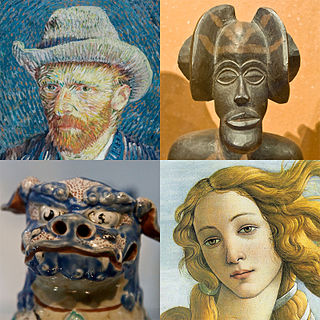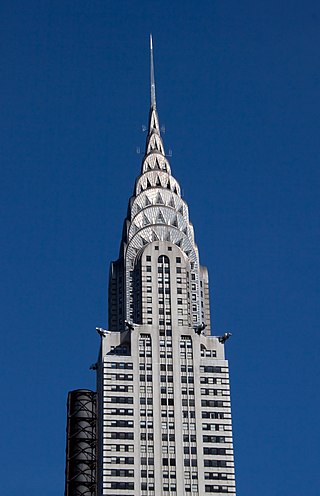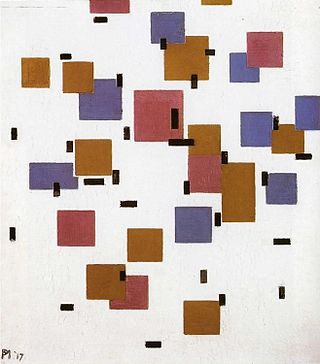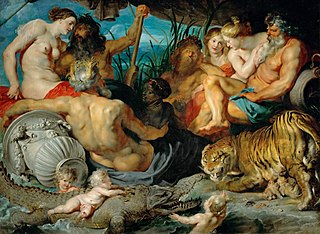Plastic arts are art forms which involve physical manipulation of a plastic medium, such as clay, wax or paint, to create works of art. The term is also used to refer to the visual arts (such as painting, sculpture, ceramics, architecture, film and photography), rather than literature and music. [1] [2] Materials for use in the plastic arts, in the narrower definition, include those that can be carved or shaped, such as stone or wood, concrete, glass, or metal.
The word "plastic" draws from the Greek word "plastikos," which means "to mold" or "to shape." It has long preceded its dominant modern meaning as a synthetic material. The term "plastic arts" has been used historically to denote visual art forms (painting, sculpture, and ceramics) as opposed to literature or music.
The related terms plasticity and plasticism became more widely used in the early 20th century by critics discussing modern painting, particularly the works of Paul Cézanne. [3]
The oldest known "plastic art" dates back to 30,000–34,000 BP. [4]
In contrast to the limiting of 'plastic arts' to sculpture and architecture by Friedrich Wilhelm Joseph Schelling in 1807, [5] the German critic August Wilhelm Schlegel (1767–1845) applied the concept not only to visual arts, but also poetry.
Classical poetry lines he saw using plastic isolation, and rhyme falling under the Romantic (domain). [6]
In Schlegel's Viennese lectures (1809–1811), published in 1827 as On the Theory and History of the Plastic Arts, he contrasted the plasticism of Classical Art with picturesque Romanticism:
[He] operated with the antinomy of terms plastic/pictorial, mechanically/ organically, finite/ infinite, and closed/accomplished. Schlegel stated that the spirit of the entire antique culture and poetry was plastic and that the spirit of modern culture, however, was picturesque (pittoresk) [7]

Art is a diverse range of human activity and its resulting product that involves creative or imaginative talent generally expressive of technical proficiency, beauty, emotional power, or conceptual ideas.

Art Deco, short for the French Arts décoratifs, is a style of visual arts, architecture, and product design, that first appeared in Paris in the 1910s, and flourished in the United States and Europe during the 1920s to early 1930s. Through styling and design of the exterior and interior of anything from large structures to small objects, including how people look, Art Deco has influenced bridges, buildings, ships, ocean liners, trains, cars, trucks, buses, furniture, and everyday objects including radios and vacuum cleaners.

Modernism was an early 20th-century movement in literature, visual arts, and music that emphasized experimentation, abstraction, and subjective experience. Philosophy, politics, architecture, and social issues were also aspects of the movement, which arose from a "growing alienation" from prevailing "morality, optimism, and convention" and a desire to change how "human beings in a society interact and live together".

In European academic traditions, fine art is made primarily for aesthetics or creative expression, distinguishing it from decorative art or applied art, which also has to serve some practical function, such as pottery or most metalwork. In the aesthetic theories developed in the Italian Renaissance, the highest art was that which allowed the full expression and display of the artist's imagination, unrestricted by any of the practical considerations involved in, say, making and decorating a teapot. It was also considered important that making the artwork did not involve dividing the work between different individuals with specialized skills, as might be necessary with a piece of furniture, for example. Even within the fine arts, there was a hierarchy of genres based on the amount of creative imagination required, with history painting placed higher than still life.

Abstract art uses visual language of shape, form, color and line to create a composition which may exist with a degree of independence from visual references in the world.

Postmodern art is a body of art movements that sought to contradict some aspects of modernism or some aspects that emerged or developed in its aftermath. In general, movements such as intermedia, installation art, conceptual art and multimedia, particularly involving video are described as postmodern.

Neoplasticism, originating from the Dutch Nieuwe Beelding, is an avant-garde art theory that arose in 1917 and was employed by Dutch De Stijl artists. The most notable advocates of the theory were the painters Theo van Doesburg and Piet Mondriaan. Neo-plasticism advocated for a purified abstract art, by applying the most elementary principles through rational means. Thus, a painting that adhered to neo-plastic theory would typically consist of simple geometric shapes, right-angled relationships and primary colors.

The decorative arts are arts or crafts whose aim is the design and manufacture of objects that are both beautiful and functional. This includes most of the objects for the interiors of buildings, as well as interior design, but typically excludes architecture. Ceramic art, metalwork, furniture, jewellery, fashion, various forms of the textile arts and glassware are major groupings.

A work of art, artwork, art piece, piece of art or art object is an artistic creation of aesthetic value. Except for "work of art", which may be used of any work regarded as art in its widest sense, including works from literature and music, these terms apply principally to tangible, physical forms of visual art:
American modernism, much like the modernism movement in general, is a trend of philosophical thought arising from the widespread changes in culture and society in the age of modernity. American modernism is an artistic and cultural movement in the United States beginning at the turn of the 20th century, with a core period between World War I and World War II. Like its European counterpart, American modernism stemmed from a rejection of Enlightenment thinking, seeking to better represent reality in a new, more industrialized world.

Anselm Reyle is a German visual artist, based in Berlin. He is known for his often large-scale abstract paintings and found-object sculptures.

Vietnamese art is visual art that, whether ancient or modern, originated in or is practiced in Vietnam or by Vietnamese artists.
In the visual arts, late modernism encompasses the overall production of most recent art made between the aftermath of World War II and the early years of the 21st century. The terminology often points to similarities between late modernism and postmodernism, although there are differences. The predominant term for art produced since the 1950s is contemporary art. Not all art labelled as contemporary art is modernist or post-modern, and the broader term encompasses both artists who continue to work in modern and late modernist traditions, as well as artists who reject modernism for post-modernism or other reasons. Arthur Danto argues explicitly in After the End of Art that contemporaneity was the broader term, and that postmodern objects represent a subsector of the contemporary movement which replaced modernity and modernism, while other notable critics: Hilton Kramer, Robert C. Morgan, Kirk Varnedoe, Jean-François Lyotard and others have argued that postmodern objects are at best relative to modernist works.

Painting is a visual art, which is characterized by the practice of applying paint, pigment, color or other medium to a solid surface. The medium is commonly applied to the base with a brush, but other implements, such as knives, sponges, and airbrushes, may be used.

Cubist sculpture developed in parallel with Cubist painting, beginning in Paris around 1909 with its proto-Cubist phase, and evolving through the early 1920s. Just as Cubist painting, Cubist sculpture is rooted in Paul Cézanne's reduction of painted objects into component planes and geometric solids; cubes, spheres, cylinders, and cones. Presenting fragments and facets of objects that could be visually interpreted in different ways had the effect of 'revealing the structure' of the object. Cubist sculpture essentially is the dynamic rendering of three-dimensional objects in the language of non-Euclidean geometry by shifting viewpoints of volume or mass in terms of spherical, flat and hyperbolic surfaces.

The arts or creative arts are a wide range of human practices of creative expression, storytelling, and cultural participation. They encompass multiple diverse and plural modes of thinking, doing, and being, in an extremely broad range of media. Both dynamic and a characteristically constant feature of human life, they have developed into innovative, stylized, and sometimes intricate forms. This is often achieved through sustained and deliberate study, training, and/or theorizing within a particular tradition, across generations, and even between civilizations. The arts are a vehicle through which human beings cultivate distinct social, cultural, and individual identities while transmitting values, impressions, judgements, ideas, visions, spiritual meanings, patterns of life, and experiences across time and space.

The visual arts are art forms such as painting, drawing, printmaking, sculpture, ceramics, photography, video, filmmaking, comics, design, crafts, and architecture. Many artistic disciplines, such as performing arts, conceptual art, and textile arts, also involve aspects of the visual arts as well as arts of other types. Also included within the visual arts are the applied arts, such as industrial design, graphic design, fashion design, interior design, and decorative art.
Dianna Molzan is an American contemporary artist and painter based in Los Angeles. Thus far in her career, she is known for exploring the relationship between painting and sculpture through deconstruction and materialization of traditional painting materials and tools.

Mrinalini Mukherjee was an Indian sculptor. Known for her distinctly contemporary style and use of dyed and woven hemp fibre, an unconventional material for sculpting, she had a career lasting over four decades from the 1970s to the 2000s. Mukherjee's body of work is a part of public collections at, among others, the Museum of Modern Art, Oxford; the National Gallery of Modern Art, New Delhi; Tate Modern, London; The Metropolitan Museum of Art, New York; and the Stedelijk Museum, Amsterdam. The artist's personal archive is digitised and freely accessible on Asia Art Archive's website.
Apart from rock art, whether engraved, drawn, or painted, there also exist some examples of early sculptures and plastic art (30,000–34,000 bp )